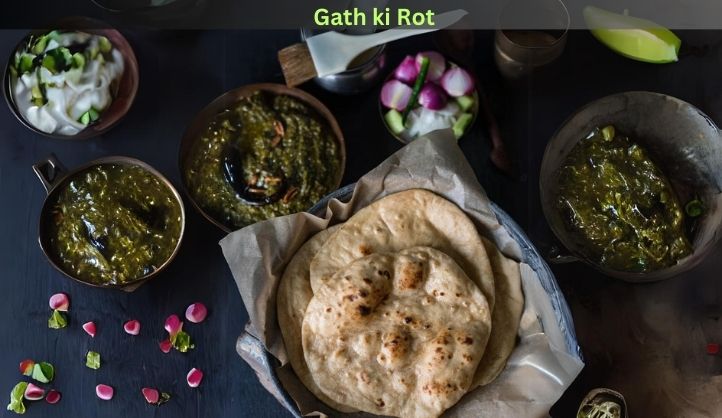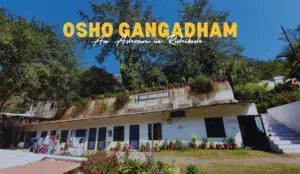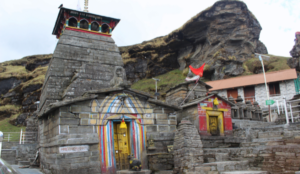Nestled in the majestic Himalayas, Uttarakhand boasts a rich culinary heritage as diverse as its landscape. Among its many treasures lies a humble flatbread – the Gath ki Roti. While its name might not be as widely known as its cousin, the Mandua ki Roti, Gath ki Roti holds a special place in the hearts (and stomachs) of the people of Uttarakhand. This article delves into the world of Gath ki Roti, exploring its history, significance, preparation methods, and the unique flavors it brings to the Uttarakhandi table.
A Nutritional Powerhouse
The star ingredient of Gath ki Roti is Gath, also known as Horse Gram or Kulthi. This ancient grain, cultivated for centuries in the foothills of the Himalayas, is a nutritional powerhouse. Packed with protein, fiber, iron, and calcium, Gath offers a plethora of health benefits. It is known to aid digestion, regulate blood sugar levels, and boost immunity – perfect for the harsh Himalayan climate.
The use of Gath in flatbreads is not new. Evidence suggests its consumption in ancient India, with references found in Vedic texts. In Uttarakhand, Gath cultivation thrived due to its adaptability to the region’s challenging terrain and weather conditions. This resilience made Gath a reliable source of sustenance for the mountain communities.
Beyond Sustenance A Cultural Touchstone
Gath ki Roti transcends its role as a source of nutrition. It is deeply woven into the cultural fabric of Uttarakhand. Traditionally, women prepare the dough before sunrise, a practice symbolizing the beginning of a new day and the importance of nourishment for the family. The act of kneading the dough and shaping the rotis becomes a form of bonding and community building, often done together by women from neighboring households.
The consumption of Gath ki Roti also holds cultural significance. It is a staple food in both Kumaoni and Garhwali cuisines, the two dominant cultural groups in Uttarakhand. It is often served during festivals and celebrations, signifying prosperity and good luck. For many, the aroma of Gath ki Roti roasting on a tawa evokes a sense of nostalgia and reminds them of home.
A Culinary Journey
Gath ki Roti, in its simplest form, is a flatbread made with Gath flour, water, and a pinch of salt. However, regional variations exist, adding a touch of diversity to this traditional dish. In some areas, a small portion of wheat flour might be mixed with Gath flour for a slightly softer texture. Spices like cumin seeds or ajwain (caraway seeds) can be added for an extra layer of flavor.
The accompaniments are as diverse as the regions of Uttarakhand. In the Kumaon region, it is often paired with Janglik chutney, a fiery condiment made with local herbs and spices. In Garhwal, it is commonly enjoyed with a dollop of Ghee, clarified butter, or a side of Aloo Tamatar ki Sabzi, a simple potato and tomato curry. Some even enjoy it with a drizzle of honey for a sweet and savory contrast.
Gath ki Roti’s versatility shines through its ability to be enjoyed for breakfast, lunch, or dinner. For a more substantial meal, it can be stuffed with mashed potatoes or lentils, transforming into a filling paratha.
A Glimpse into Traditional Methods
Making Gath ki Roti is a process steeped in tradition. Gath, unlike wheat, requires soaking overnight to soften the hard outer shell. The soaked Gath is then sun-dried and ground into coarse flour using a traditional grinding stone called a Sil Batta. This method preserves the grain’s nutrients and adds a unique texture to the roti.
The prepared Gath flour is then mixed with water and salt to form a dough. Unlike wheat dough, Gath dough is slightly crumbly and requires a gentle kneading technique. Small balls of dough are rolled out into thin circles before being cooked on a preheated griddle or tawa. The roti is cooked on both sides until golden brown and puffed slightly. A generous amount of ghee is often brushed onto the cooked roti, adding a touch of richness and enhancing its flavor.
The entire process, from soaking the Gath to the final flourish of ghee, is a testament to the skill and patience of the women who prepare this dish. In recent times, commercially available Gath flour has made the preparation process easier. However, the traditional methods are still cherished by many and passed down through generations.
In addition to Gath ki Roti, Uttarakhand boasts a delightful array of dishes that showcase the region’s unique flavors and cooking techniques. Here’s a glimpse into some must-try delicacies:
- Kafuli: Kafuli is popular dish, considered the state food of Uttarakhand, features leafy greens like spinach, fenugreek, and lai simmered in a flavorful broth.
- Phaanu: Phaanu is a hearty lentil stew made with various dals, spices, and onions, perfect for a comforting meal.
- Aloo Tamatar Ka Jhol: Aloo Tamatar ka Jhol is a simple yet delicious curry featuring potatoes, tomatoes, onions, and a touch of spice, often enjoyed with rice or roti.
- Bhang ki Chutney: Bhang ki Chutney is a unique condiment made with cannabis leaves (traditionally used without the psychoactive ingredient THC), offering a pungent and earthy flavor.
- Mandua ki Roti: Another staple flatbread made with finger millet flour, known for its slightly tart flavor and dense texture.
- Jhangora Ki Kheer: Jhangore ki Kheer is a sweet pudding made with Jhangora (foxtail millet), milk, and jaggery, offering a delightful combination of textures and flavors.
- Singodi: Singodi is a festive sweet dish made with roasted and powdered wheat berries, nuts, and ghee, often enjoyed during special occasions.
- Arsa: Arsa is a Deep-fried, flattened rice cake dipped in sugar syrup, a melt-in-your-mouth sweet treat.
- Dubuk: Dubuk is a stir-fried dish made with fermented soybean chunks, a protein-rich and flavorful option.
- Chainsoo: Chainsoo is a tangy soup made with local greens and yogurt, perfect for a light meal or as a digestive aid.
This is just a taste of the culinary treasures that Uttarakhand has to offer. Each region within the state might have its own variations and specialties, making exploration a delicious adventure.
A Legacy Enduring
The increasing awareness of Gath’s nutritional benefits is contributing to a renewed interest in Gath ki Roti. Fitness enthusiasts and those seeking gluten-free options are discovering the unique qualities of this ancient grain. Restaurants in Uttarakhand are now incorporating Gath ki Roti into their menus, introducing it to a wider audience.
However, challenges remain. The cultivation of Gath is labor-intensive, and competition from commercially produced grains can make it less profitable for farmers. Additionally, the younger generation, particularly those living in urban areas, might be less familiar with traditional dishes like Gath ki Roti.
To ensure the future of Gath ki Roti, several initiatives are underway. Government programs are promoting Gath cultivation through subsidies and improved farming techniques. Local communities are organizing workshops and demonstrations to teach younger generations about Gath and its culinary uses.
There’s also a growing interest in promoting Gath ki Roti as a sustainable and healthy food option. Its low water requirements and high nutritional value make it ideal for a resource-constrained world. Food bloggers and chefs are experimenting with Gath ki Roti recipes, creating innovative ways to incorporate them into modern diets.
Conclusion
Gath ki Roti is more than just a flatbread; it’s a symbol of resilience, cultural heritage, and the resourcefulness of the people of Uttarakhand. Its journey, from the slopes of the Himalayas to dinner tables, is a testament to the enduring legacy of traditional foodways. As we move forward, the future of Gath ki Roti lies in embracing its unique qualities, promoting sustainable practices, and fostering a connection between this ancient grain and a new generation.
FAQs about Gath ki Roti
What is Gath ki Roti?
Gath ki Roti is a flatbread originating from Uttarakhand, India. Made with Gath flour (also known as Horse Gram flour), it’s a nutritious and flavorful staple food in the region.
What are the health benefits of Gath ki Roti?
Gath flour is packed with protein, fiber, iron, and calcium. Gath ki Roti can aid digestion, regulate blood sugar levels, and boost immunity.
How is Gath ki Roti different from other Rotis?
Unlike wheat rotis, Gath ki Roti is made with a unique flour and has a slightly crumbly texture. It’s often paired with different accompaniments depending on the region.
How is Gath ki Roti traditionally made?
Gath is soaked overnight, sun-dried, and ground into flour using a grinding stone. The flour is then mixed with water and salt to form a dough, rolled out, and cooked on a griddle.
What are some popular accompaniments to Gath ki Roti?
In Kumaon, it’s enjoyed with Janglik chutney, while Garhwal prefers Ghee or Aloo Tamatar ki Sabzi. It can also be eaten with honey or stuffed with vegetables for a more substantial meal.
Where can I learn more about Gath ki Roti?
You can find recipes and information about Gath ki Roti online or through travel blogs focusing on Uttarakhandi cuisine. Visiting Uttarakhand and experiencing it firsthand is another way to delve deeper into this unique dish.





